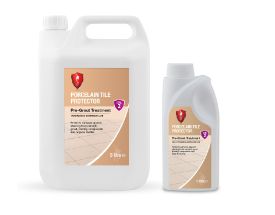
Porcelain pavers have become increasingly popular outdoors. A stunning range of design options has played a part – today’s natural effects are incredibly authentic – but the biggest driver is porcelain’s durability. Porcelain is renowned for its practical features and this is largely due to its density, which makes it tough and resistant. A combination of fine particles and high temperature firing during manufacture creates a surface that’s very hard and less porous than natural materials, making it especially resistant to water and stains. But these benefits don’t remove the need for maintenance; whilst porcelain won’t readily absorb dirt, residue will still accumulate on the surface, compromising the aesthetic and the tile’s performance.
To retain a tile’s aesthetic and performance features – and to restore older tiles – we recommend the following steps:
New patio installations
Unpolished porcelain tiles don’t need to be sealed but they will benefit from application of a barrier treatment before grouting. This is because during installation grout and other residues will become trapped in the tile’s textured ‘high-low’ surface. Trapped residues will compromise the look of the tile, creating a tell-tale white haze across the tile surface. Maintenance will also be more difficult and a build-up of residue will create a slip hazard.
To protect tiles during installation, we recommend LTP Porcelain Protector. It’s a water-based ‘pre-and-post-grout’ treatment that’s designed to protect the tiles from staining and allow easy removal of residues like cement-based grout, two-part resin based jointing compounds and stubborn dirt. Porcelain needs to be kept as wet as possible during installation, to improve and increase grout working times, and the protector helps in this respect too.

Before the protector is applied, the tiles should be cleaned and left to dry overnight. To apply the protector:
- Use a broad paint brush, foam roller or light pressure sprayer.
- Leave to dry for 30 minutes before applying a second coat.
- Leave the treatment to cure for a minimum of one hour before grouting or pointing. Once the grout is dry, and all residues have been removed, a further coat of Protector can be applied to the tiles and the grout joints. This helps with future cleaning and aftercare.
Renovating older tiles
To remove grout residue and white haze from existing installations, without damaging the joint or the paver, we recommend LTP Solvex – a non-caustic intensive cleaner/stripper. Solvex helps to soften the resin residues, allowing for easier removal. Application is normally followed by a final wash with LTP Grimex cleaning solution before rinsing down.


How to use LTP Solvex & Grimex:
- Pour Solvex directly onto the pavers.
- Apply generously by dabbing onto stains with a cloth or brush. NB. Always wear gloves to protect your hands.
- Work in manageable areas; normally in strips as far as you can reach without treading into the solution. Do not brush out.
- Leave for up to 30 minutes, but don’t allow the solution to dry out. If it starts to dry out within this time-frame, apply more solution.
- Use a coarse, stiff brush or LTP Black Emulsifying Pad to remove the softened coating from the surface of the paver. Repeat this process if some staining remains.
- Wash down the pavers with LTP Grimex, diluted 1:3 with water.
- Rinse with plenty of water and leave to dry.
As well as tackling brush-in resin grout, LTP Solvex can be used to remove wax, oil, silicone, acrylic and polyurethane sealer from porcelain. It can also be used on stone, travertine, terracotta, slate, sandstone, flagstones, quarry tiles and glazed ceramic.
Ongoing maintenance
Jet washing may seem like the best method for a fast clean but it will only wash dirt off the tile surface. High pressure water will also damage the grout joints. A specialist treatment, on the other hand, will react with the residue and organic matter, and will help break it down.
To thoroughly clean a porcelain patio, we recommend LTP Grimex. Grimex can be used at different dilutions depending on the severity of staining. See the Technical Data Sheet for information on dilutions. Tiles are washed, using a brush or garden broom, and rinsed with clean water. There’s lots of information about LTP Grimex on the product page, including a link to a Video Aid.
For periodic cleaning, you can also use LTP Porcelain Floor Tile Cleaner. This detergent can be used inside and outside, so it’s especially practical for surfaces installed from home to garden, through bi-fold doors. Just dilute 2 or 3 capfuls in a bucket of warm water – or 5 on dirtier floors – wash the floor and allow to dry. This product doesn’t require rinsing.
To remove other stains from outdoor slabs, solutions include LTP Blackspot & Algae Remover, LTP Rust Stain Remover and, for efflorescence, LTP Cement Grout & Salt Residue Remover. All three treatments are safe to use on porcelain and stone tiles.
Establishing a regular cleaning routine
We recommend cleaning porcelain pavers every couple of months or so – ideally, three times during late spring/summer and a couple of times during the winter. Surfaces that are regularly cleaned will be easier to keep clean – and it will help to maintain a new aesthetic, as well as the tile’s performance features.
For more expert advice and information, contact the LTP team on tel. 01823 666213 or email [email protected]



